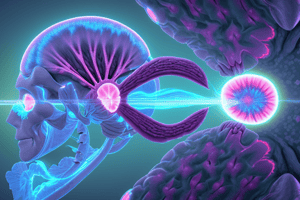Podcast
Questions and Answers
Which is in order of decreasing echogenicity?
Which is in order of decreasing echogenicity?
- Renal cortex, spleen pancreas, renal sinus
- Renal sinus, spleen, pancreas, renal cortex
- Renal sinus, liver, pancreas renal cortex
- Renal sinus, pancreas, spleen, renal cortex (correct)
Parasitic infections:
Parasitic infections:
- are more commonly located in the left lobe of the liver
- are more commonly located in the caudate lobe
- have a random hepatic distribution
- are more commonly located in the right lobe of the liver (correct)
A hepatic cyst with a detached endocyst (water lily sign) is a sonographic sign representing a(an):
A hepatic cyst with a detached endocyst (water lily sign) is a sonographic sign representing a(an):
- Amebic abscess
- Pyogenic abscess
- Hydatid cyst (correct)
- Subcapsular hematoma
Flashcards
Echogenicity order
Echogenicity order
Renal sinus, pancreas, spleen, renal cortex decrease in echogenicity.
Common location of parasitic infections
Common location of parasitic infections
Parasitic infections are often found in the right lobe of the liver.
Water lily sign indication
Water lily sign indication
A detached endocyst signifying a Hydatid cyst in ultrasound imaging.
Alpha fetoprotein increase
Alpha fetoprotein increase
Signup and view all the flashcards
Main portal vein formation
Main portal vein formation
Signup and view all the flashcards
Portal vein flow
Portal vein flow
Signup and view all the flashcards
Oxygen supply to the liver
Oxygen supply to the liver
Signup and view all the flashcards
Hyperbilirubinemia significance
Hyperbilirubinemia significance
Signup and view all the flashcards
Mass linked to oral contraception
Mass linked to oral contraception
Signup and view all the flashcards
Daughter cyst association
Daughter cyst association
Signup and view all the flashcards
Caudate lobe enlargement causes
Caudate lobe enlargement causes
Signup and view all the flashcards
Portal hypertension secondary signs
Portal hypertension secondary signs
Signup and view all the flashcards
Von Gierke disease relationship
Von Gierke disease relationship
Signup and view all the flashcards
Hepatic candidiasis sonographic sign
Hepatic candidiasis sonographic sign
Signup and view all the flashcards
Caudate lobe location
Caudate lobe location
Signup and view all the flashcards
Cavernous hemangioma appearance
Cavernous hemangioma appearance
Signup and view all the flashcards
Diffuse hepatic pathology in AIDS
Diffuse hepatic pathology in AIDS
Signup and view all the flashcards
Covering of liver and portal triad
Covering of liver and portal triad
Signup and view all the flashcards
MPV Doppler analysis
MPV Doppler analysis
Signup and view all the flashcards
Hepatic mass associated with glycogen storage
Hepatic mass associated with glycogen storage
Signup and view all the flashcards
IVC dilation classification
IVC dilation classification
Signup and view all the flashcards
Normal alpha fetoprotein
Normal alpha fetoprotein
Signup and view all the flashcards
Cirrhosis effect on liver structure
Cirrhosis effect on liver structure
Signup and view all the flashcards
Ultrasound findings in candidiasis
Ultrasound findings in candidiasis
Signup and view all the flashcards
Doppler waveform analysis finding
Doppler waveform analysis finding
Signup and view all the flashcards
Cavernous hemangioma ultrasound characteristics
Cavernous hemangioma ultrasound characteristics
Signup and view all the flashcards
Portal vein function
Portal vein function
Signup and view all the flashcards
Sonographic run of Hemolysis
Sonographic run of Hemolysis
Signup and view all the flashcards
Hepatic adenoma identification
Hepatic adenoma identification
Signup and view all the flashcards
Study Notes
Question 41
-
Which is in order of decreasing echogenicity?
-
Renal sinus, pancreas, spleen, renal cortex
Studying That Suits You
Use AI to generate personalized quizzes and flashcards to suit your learning preferences.




